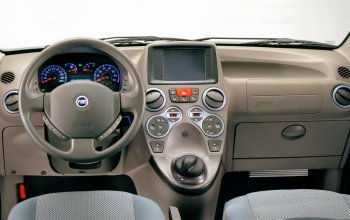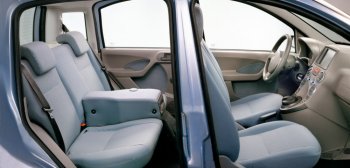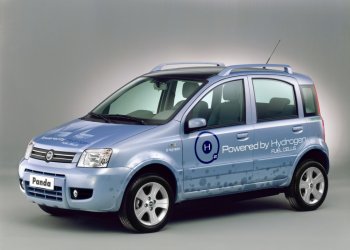|
The Panda
Hydrogen, a car prototype driven by a hydrogen Fuel Cell,
was designed with the aim of safeguarding the environment:
one of Fiat’s basic priorities during the development of new
models.
The Panda Hydrogen is a true hydrogen prototype with a
sturdy, reliable drive system. Most importantly, its vehicle
performance and roominess are on a par with those offered by
its conventional counterpart. It is the result of a joint
venture between Fiat Auto, the Fiat Research Centre and Fiat
Powertrain Research & Technology with the support of the
Research and Environment Ministries. It was also developed
in co-operation with top-quality component suppliers, almost
all of them Italian.
Unlike other Fuel Cell prototypes introduced in the past,
the Panda Hydrogen incorporates a full power system, i.e. it
lacks a drive battery for the accumulation of electrical
energy. The new Fuel Cell System (electrical power
generator) is able to deliver all the power required by the
electric engine to ensure great vehicle handling. This new
generation Fuel Cell System offers very high generating
efficiencies. The system consists mainly of three fuel cells
manufactured by Nuvera (an Italo-American company and a
leader in the fuel cell field), an innovative turbo-blower
to supply the cells with air, a humidification and cooling
system for correct management of reagent gases and a set of
auxiliary components, all developed within the Fiat Group.
On the Panda Hydrogen, the Fuel Cell System is housed
beneath the floorpan. The fuel cells are made up of several
cells connected in series. Inside, the hydrogen and oxygen
molecules are forced to react with the aid of a catalyst to
produce water and heat. Electrical energy is generated with
very high efficiency and zero emissions from the vehicle
itself. The electrical power generation system is supplied
with hydrogen at a pressure of 1.5 bars and oxygen contained
in the air. It produces electrical energy so efficiently
that 60% is available at just 20% of maximum power.
|
 |
|
|
 |
|
|
|
 |
|
|
|
The Fuel Cell System installed on the Panda Hydrogen also
features excellent performance at low temperatures and a
relatively simple construction that makes it particularly
suitable for the production of light, sturdy and reliable
generators for use on vehicles. The alternating current
three-phase asynchronous electric engine and the
transmission are located in the engine compartment together
with the various accessories required to operate the system
as a whole. The hydrogen that feeds the Fuel Cell is
contained at a pressure of 350 bars in a tank made out of
composite material installed beneath the car’s rear floor
pan. All the distinguishing features of the New Panda
passenger compartment are therefore maintained, including
outstanding roominess for four people.
At full power, the Fuel Cell engine on the Panda Hydrogen
delivers 60 kW that allows the car to reach a top speed of
more than 130 km/h, with acceleration from 0 to 50 km/h in 5
seconds. The car can also easily climb a gradient of 23% at
take-off. The hydrogen tank capacity guarantees the Panda
Hydrogen a range of more than 200 km over an urban cycle.
Refuelling time is very quick at less than 5 minutes, i.e.
comparable to the time taken to refuel a methane car.
The Panda
Hydrogen is the latest outcome of a technological
development line that has seen Fiat Group companies playing
a leading role in the field of alternative minimum
environmental impact power units. Though Fuel Cell
propulsion systems will not be widely available before the
end of the next decade, Fiat has already been active in
their development and application for a few years – as we
saw in 2001 with the debut of the Seicento “Elettra H2 Fuel
Cell, and then the Seicento Hydrogen. The Panda Hydrogen has
now taken up the baton to move research forward from the
laboratory prototype stage to that of a field research
vehicle.
2006 will see the beginning of the demonstration stage of
small Panda Hydrogen fleets, as a forerunner to wide-ranging
demonstration programmes promoted and supported by the
European Union and by the Italian Ministries and Regions.
The ultimate aim is for such vehicles to be marketed within
15 – 20 years.
|
|
|
|
![]()
![]()